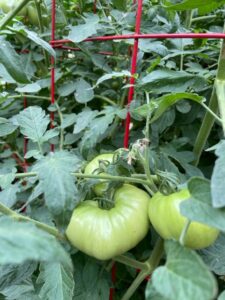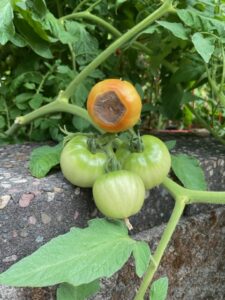 If your vegetables are sulking, turning into pudding, coated in flies, or otherwise straying from the centerfold models in Organic Gardening, you can always hit the internet. You’re not necessarily going to get two sides of the internet to line up for you, but that doesn’t bother me. When it comes to gardening, I don’t expect any two gardeners to agree.
If your vegetables are sulking, turning into pudding, coated in flies, or otherwise straying from the centerfold models in Organic Gardening, you can always hit the internet. You’re not necessarily going to get two sides of the internet to line up for you, but that doesn’t bother me. When it comes to gardening, I don’t expect any two gardeners to agree.
That all dates back to the tomato incident of 1977. I was a mere spectator. Two women, both aggressive pacifists, both saturated with sweet earth-mama vibes, both positively radiating well-being, well—they got to discussing a shared plot of tomatoes and, specifically, the watering thereof. Their voices started out dulcet and escalated into fractured sopranos, and it wasn’t clear who, in the strain of competitive serenity, was going to come out on top. All I know is one of them advocated for morning irrigation and the other was adamant that evening was best. No one was budging. At some point I believe tofu was thrown.
Surely there was a time when people in general knew the right answer to questions like these. It was wisdom passed down through the ages through generations of folks who couldn’t just walk ten minutes to the grocery store if things didn’t work out. One would think they had it down. But I wonder.
 There are plenty of stories of farmers resisting demonstrably good new techniques with all their might, as though their very ancestors would rise up scandalized from their graves. Habit dies hard. Say you believe you should plant your beans naked at midnight on the first full moon after Hornswoggle or some other Druid feast day. That’s specific enough to be persuasive. But for all we know it might all have originated with someone’s great-great-great-grandmother on one drunken toot and it worked out that year, and now we’re stuck with the bean protocol, even though it’s been hit or miss ever since. It might be the horticultural equivalent of wearing the same unwashed sweatshirt on game day you were wearing when your team took home the trophy.
There are plenty of stories of farmers resisting demonstrably good new techniques with all their might, as though their very ancestors would rise up scandalized from their graves. Habit dies hard. Say you believe you should plant your beans naked at midnight on the first full moon after Hornswoggle or some other Druid feast day. That’s specific enough to be persuasive. But for all we know it might all have originated with someone’s great-great-great-grandmother on one drunken toot and it worked out that year, and now we’re stuck with the bean protocol, even though it’s been hit or miss ever since. It might be the horticultural equivalent of wearing the same unwashed sweatshirt on game day you were wearing when your team took home the trophy.
There’s all sorts of advice. There’s the vaunted Three Sisters method of companion planting, which is genuine Native American lore. Lore, in general, is a vital component of successful gardening. First you plant the corn. Then plant beans around it so they’ll have the corn to climb on, and then pop in some squash to act as a natural mulch and crowd out weeds. It’s a good start, but then you throw in a vanguard of marigolds to annoy the nematodes, surrounded by Brussels sprouts to repel the neighbors, and ring it all with explosives on a tripwire to thwart raccoons. All well and good but by now the raccoon population has learned to interpret airborne raccoon shrapnel as evidence the corn is ripe and currently unprotected.
 However, if you do have a good source of lore, you should apply it liberally. An example: it is considered helpful to bury a dead fish under your tomato plants. I’ve found it works just as well with a live one. And if your lore is stale, they’re always making it fresh. For instance, when I Googled blossom end rot—a familiar tomato affliction around here, wherein your tomato looks like it is rising from the grave—I quickly learn that it has to do with calcium uptake and consistent watering. One site suggested “3 Easy Steps to fix blossom end rot,” and included a photo of the proprietor, certifiably Earth Mama material. The first step was to throw out the affected tomatoes. The second was to water with powdered milk. A powdered milk cure has “lore” written all over it. Unfortunately—she goes on to report—she found out that plants can’t actually absorb calcium from powdered milk, but was unwilling to change the advice because (she admitted) then nobody would click on her site.
However, if you do have a good source of lore, you should apply it liberally. An example: it is considered helpful to bury a dead fish under your tomato plants. I’ve found it works just as well with a live one. And if your lore is stale, they’re always making it fresh. For instance, when I Googled blossom end rot—a familiar tomato affliction around here, wherein your tomato looks like it is rising from the grave—I quickly learn that it has to do with calcium uptake and consistent watering. One site suggested “3 Easy Steps to fix blossom end rot,” and included a photo of the proprietor, certifiably Earth Mama material. The first step was to throw out the affected tomatoes. The second was to water with powdered milk. A powdered milk cure has “lore” written all over it. Unfortunately—she goes on to report—she found out that plants can’t actually absorb calcium from powdered milk, but was unwilling to change the advice because (she admitted) then nobody would click on her site.
Well, there’s some consensus that tomatoes should be watered consistently, and in the morning, but I do not always have the New York Times Spelling Bee solved by noon, and frankly if anything in my garden needs to be watered consistently, it had better thrive in November. Me, I like to keep my garden guessing.
But here’s a tip. If you run across an antique aphorism that rhymes and has a nice rhythm to it, that’s a good sign. Sprinkle your plat when the sparrow sings flat and the spurge creeps long on the patio. If you can find it attributed to both Morgan Freeman and Ben Franklin, you can bet the ranch on it. As a combo, those two are loaded with gravitas.
Speaking of which, a handful of gravitas in the tomato hole at planting is said to ward off frivolity.
Several years ago, we had blossom end rot on our tomatoes. It was REALLY rainy that spring, and it leached the nutrients, especially calcium, from the soil. (I think Paul adds some bone meal to the soil now, because we seem to get rainy springs anymore.) Too much watering is not good, but what can you do when it’s raining all the time? In order to figure out if they need watering, Paul sticks a finger into the soil. If it’s moist, they don’t need water. I remember the advice of the late plant guru, Jerry Baker: “Don’t be a Jewish mother to your plants. The worst thing you can do is over-water.”
It all has to do with calcium and consistent watering of some sort and I’m not sure if the person with the hose has to be naked or not.
God, I hope not! Our long-suffering neighbors don’t need to see THAT!
Lore in some Appalachian hollers has it that you need to cook your greens in 7 changes of water. I say, you should WASH your greens in 7 changes of water before ya cook ’em, or ye’ll get grit in yer dentures.
Mmm. Ramps!
I quite liked ramps. Went to a festival or two.
Tomato issues give me the willies. Blossom end rot sounds like something old people have to endure, like age spots and wattles. And have you ever been picking your tomatoes and grabbed ahold of a well-nourished Horn Worm? There’s willies, and then there’s Horn Worm Willies. I will pay good money to folks who will take all that off my hands.
Years ago I had a Tokay Gecko, a large flamboyantly colored lizard with a large and flamboyant temper to match. His name was Asmodeus (Prince of Anger) after the demon.
Asmodeus only freaked out over a food offering once . I’d found a tomato horn worm out in the garden and thought he might approve of it.
He spotted it when I walked in the bedroom door and jumped to the side of the tank closest to me. When I opened the lid, he was right there at the top and snatched the caterpillar from my fingers and proceeded to bolt it down.
I’d obtained him back in the days before captive breeding. I’m sure he had been born in the wild somewhere in Southeast Asia and that tomato horn worm looked and tasted like something he had known and loved.
As a matter of interest, I mentioned my first and only acquaintance with the tomato hornworm in a post I haven’t published yet. But soon!
Since I started adding agricultural lime to the soil every year, I’ve had no blossom end rot. Since I planted lots of alyssum, the parasitic wasps it attracts have taken care of the hornworms (yes, there’s another poem there, and it’s pretty good, but I’ll spare you), except for one hornworm that survived, and a scrub jay ate that one. I think a hooded oriole munched a bit on my tomatoes this year, so I wrapped them in netting. The tomatoes, not the orioles. I have not yet tried explosives against the raccoons, but it sounds like a terrific idea. I don’t think we’re zoned for that, though.
Now I’m wondering if we even get hornworms here. What do they turn into? I’ll look it up. I have got the most tomatoes ever this year and they’re all green except that one in the picture, and it has rot.
Huh. Looks like it turns into Buffalo Bill’s corpse throat moth. Fabulous. And we have them. Fabulous.
I grew tomatoes in Oregon for years and never saw a tomato hornworm until we moved to Colorado. I remember screaming. Those things are big and ugly. I’m guessing you don’t get them in the Pacific Northwest. Haven’t seen one in Idaho either, but, man, the squash bugs here will suck the life out of your squash plants in record time.
“Squash bugs.” Is that a new name for squirrels?
If you figure out how to include squirrels in the the bunch of raccoons I would like to sacrifice a few of them to the creator of the hornworms too. Just sayin- they can cause a lot of damage!
See above. Suckers ate all my acorn squash last year and ate my solar energy a few years back, too.
Question for my Murrminded friends: If I plant tomato seedlings and, at full growth, acquire hornworms, where did those caterpillars come from? How did they find my tomatoes? Are there stealth hornworms living rough all over the place until I plant them homes? Are hornworms gifted olfactorally speaking and can they zero in on a tomato plant like a bloodhound? What a world.
The sphinx moths (or five-spotted hawkmoths) are the gifted ones. They’ll find your tomato plants (I don’t know if it’s by sight, by smell, by taste, or all of the above) and they’ll lay their eggs on the undersides of tomato leaves in the spring (at night, when you’re not looking, I would guess). Four or five days later they’ll hatch.
Maybe those small hornworms have even smaller drones — about the size and shape of a mosquito — to scope out where the tomato plants are. And really, so many people plant tomatoes anymore that they won’t have far to crawl to get to them. Fortunately, I have never ever seen one. I HAVE had blossom end rot, aphids, and all manner of plant pests. But so far, no hornworms.
I met someone who’d had no experience growing tomatoes. She looked out her window and was delighted with the mass of greenery she saw…then she looked more closely and saw that what she thought, on seeing them from her window, were tomato leaves, were all actually hornworms just finishing off her plant. Ick. I think she quit growing tomatoes.
I said I wouldn’t but here it is anyway:
AERIAL SURVEY
The hawkmoth knows
she will have to provide for her offspring
somewhere else
she sees that my tomato plants
are guarded by a forest of alyssum
whose flowers are already drawing
the tiny parasitic wasps
whose children would devour hers
were she so foolish
as to lay
her eggs nearby
she doesn’t even have to think it over
but it rained very hard last night
and I still believe
that as she flies past my garden
she takes a bit of comfort
at the sight of the rain-crushed alyssum
beaten flat against the earth
looking like that forest in Siberia
after the Tunguska Event.
©2015 by Jeremy Cantor
Thank you Jeremy! I loved that.
Wonderful!
All I know is succulents mostly survive whether you water or not, but for more delicate things, in late spring and early summer at least it’s best to water in the later afternoon/evening so the plants have all of the slightly cooler night time to soak it up. Morning water just evaprates by midday. Well it does where I live.
Here too, but that’s when I remember to water. Oy.
Hornworms are really common here in Texas and for a long time I routinely squashed them even though I thought they were quite beautiful. It didn’t seem right to destroy something that pretty, so I googled them and discovered they also liked grapevines as well. Well. We have wild grapevines everywhere on the property so when a hornworm showed up on a tomato vine they were schlepped carefully to a grapevine and my conscience was once more on an even keel.
You’d probably need a wagon to shlep with.
Sadly, not this year. The unrelenting heat dome parked over our heads has fried the vegetation completely and as a result the bug population has plummeted. My bees, wasps and ants are desperate for water along with their sugar nectar and the birds are flocking to my feeders. Even the mosquitoes have left the building. I really miss the butterflies…